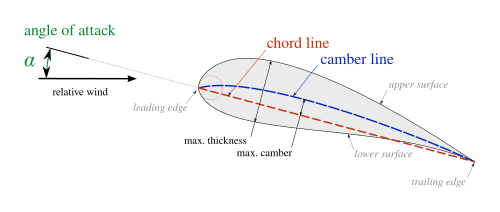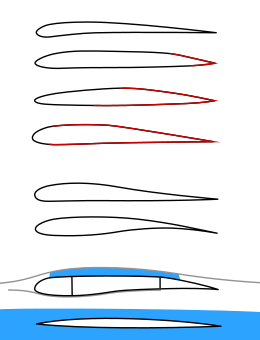

- #Wing airfoil skin#
- #Wing airfoil free#
Figure 5: Circulation of Air Around Wingįigure 6: Vector Addition Results in a Lower Velocity Below The Wing and a Higher Velocity Above The Wing
#Wing airfoil free#
The velocity vectors from this counter circulation add to the free flow velocity vectors, thus resulting in a higher velocity above the wing and a lower velocity below the wing (see Figure 6). This takes the form of circulation around the wing, as shown in Figure 5. To satisfy the conservation of angular momentum, there must be an equivalent motion to oppose the vortex movement.

Figure 4: Starting Vortex FormationĪs shown in Figure 4, the starting vortex rotates in a counter-clockwise direction. The effects of viscosity lead to the formation of the starting vortex (see Figure 4), which, in turn is responsible for producing the proper conditions for lift. Viscosity is essential in generating lift. a) Flat Bottom b) Slightly Curved Bottom c) Symmetrical Note: There Are An Infinite Number of Possibilities i.e. However, the airfoils shown in Figure 3 are useless without viscosity.
Inclined relative to the airflow direction. To create this pressure difference, the surface of the wing must satisfy one or both of the following conditions. Since the pressure below the wing is higher than the pressure above the wing, there is a net force upwards. The wings provide lift by creating a situation where the pressure above the wing is lower than the pressure below the wing. Points halfway between chord and upper wing surfaceĪngle between direction of airflow and the chord Figure 2: Typical Airfoli (Cross-Sectional Shape) of An Airplane WingĮxtends from leading edge to trailing edge of the wing A typical airfoil and its properties are shown in Figure 2, and are also described below. The cross-sectional shape of the wing is called an airfoil. The airplane generates lift using its wings. Figure 1: The Four Forces Acting on an Airplane Balloons and airships stay up off the ground because the gas inside them is lighter, or less dense, than the air outside. What is an airfoil? When an airfoil moves through the air, it produces lift because the force of the air pushing down on its top surface is less than the force of the air from below. Lift and weight are two of the four forces acting on an airplane, the other two are drag and thrust (see Figure 1). #Wing airfoil skin#
The shape of the airfoil determines the amount of turbulence or skin friction, are controlled mainly by the fineness ratio, the efficiency of a wing is measured in terms of the lift to drag ratio (L/D. Thus, it can be stated that any part of the aircraft that converts air resistance into lift is an airfoil.
 An airfoil is a surface designed to obtain lift from the air through which it moves. The values produced by xFoil are for the airfoil section only and do not take into account the rest of the aircraft components. The wing (airfoil section) is assumed to be infinitely long and as such the induced drag component as a result of vortex roll-up at the wingtips is neglected. MAIN FUNCTIONAL REQUIREMENT: Provide enough lift to counter the weight of the plane. WINNER OF THE 1999 BEST REPORT REWARD!!! AIR FOIL
An airfoil is a surface designed to obtain lift from the air through which it moves. The values produced by xFoil are for the airfoil section only and do not take into account the rest of the aircraft components. The wing (airfoil section) is assumed to be infinitely long and as such the induced drag component as a result of vortex roll-up at the wingtips is neglected. MAIN FUNCTIONAL REQUIREMENT: Provide enough lift to counter the weight of the plane. WINNER OF THE 1999 BEST REPORT REWARD!!! AIR FOIL







 0 kommentar(er)
0 kommentar(er)
